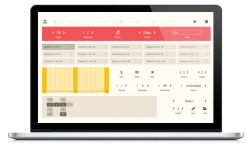 Feelyoursound.com has updated its MIDI composition software Sundog Scale Studio, for Mac & Windows, to version 1.4.0.
Feelyoursound.com has updated its MIDI composition software Sundog Scale Studio, for Mac & Windows, to version 1.4.0.
Sundog is a stand-alone MIDI sequencer that is designed to provide tools focused on composition.
It works like this:
- Connect Sundog to your DAW via MIDI.
- Pick a scale – like C Major or E Minor.
- Sundog will show you a list of chords that can be used on this scale.
- Create a chord progression by clicking and listening.
- Use the internal step sequencer to create melodies or arpeggios on your chords and scale notes.
The update adds enhanced sequencing options, improved MIDI support, ‘tighter’ MIDI clock, new views and more.
Here’s a video intro:
Here’s what’s new in version 1.4.0:
- Work as MIDI Clock slave.
- Sequencer: Up to 24 notes up or down instead of 9.
- Octave +1, +2, -1, -2 (right click: go down).
- MIDI Panic button: Press “P”.
- Tighter MIDI clock for MIDI master mode.
- Accessibility-Fix (create file core/accessibility.txt).
- Mute instruments in instrument selector panel without changing the current instrument (click on the playback indicator dot to mute an instrument).
- Chords View: Show “chord column number” in chord progression bar.
- Chords View: Underline inversions and other chords that share exactly the same notes as the current chord.
- Copy and Paste: Input sequences, chords, chord progressions, melodic patterns.
- Edit menu with actions like “Set all patterns to triplets”.
- Clear chord in Chords View with keypress: Delete (Windows) or backspace (Mac OS X).
- Triplet support.
Sundog Scale Studio is available for Mac & Windows for $39 / EUR 29.
If you’ve used Sundog, leave a comment and share your thoughts on it!

Automation of music creation
Genocide of the creative process
Nah… there are so many aspects involved in music production – sound choice, synthesis, mixing, building / releasing tension, harmony,… – that you can hardly say that using a tool that helps you in _one_ category will help you with _everything_ (or “kills” music making).
Sundog definitely speeds up the production process. But it won’t free you from your responsibility as a musician to amaze your audience – by following your vision of a good song, and then using your whole toolset and knowledge to let your vision become reality.
I wouldn’t say it is automation – as the user is making key choices of scale, notes and progressions in composition, it seems more to be an interactive reference for music composition. Couldn’t a creative come to the same conclusions after referencing a small library, with more time and effort needed? It is like stating that an interactive reference for the English language is going to destroy the creative writing process, it won’t diminish you but it could seriously help that process, regardless of previous knowledge it may take a person down new creative paths.
If anything, a tool like this forces you to learn more about writing songs, because you focus more of your time on arrangement, feel, tension and release, etc. A symphony conductor doesn’t play every single part in every single instrument. They rely on tools and people to help them reach their overall vision. Slot this tool in the same way.
Seems like it would make a perfect iOS app.
I know this is narrow minded, but I was quite interested in this… until I watched the demo and heard that paint-by-numbers trance song. ugh.
Can the user manually adjust the chord inversion being used?
There are two ways to work with inversions:
1) Click on a chords button. Sundog will automatically underline every other chord that uses the same notes. Now you can decide to switch chords by clicking on one of the other buttons.
2) If you click on a chord Sundog will highlight the used notes in the yellow box below the chords buttons. Now you can click on single notes to manually turn them off and on. This way you can both create completely own chords and also do inversions if you like
setting it up is a pain on a mac. No instructions for dummies like me. I don’t want to put it through Logic X. Just run it through my MacBook, maybe quick time then drag and drop into daw.